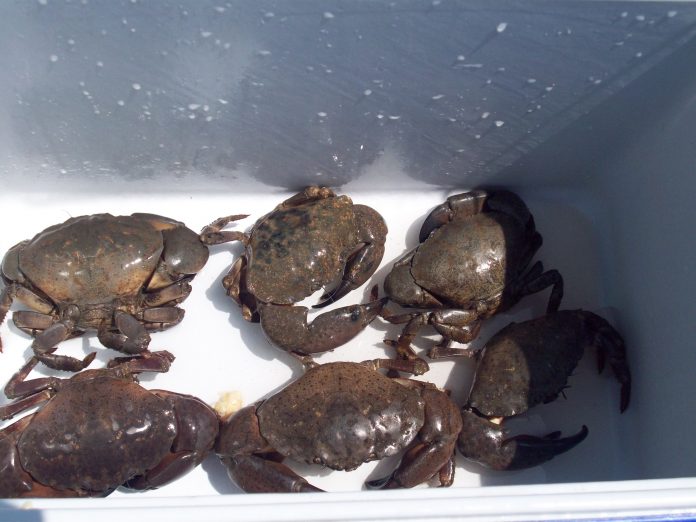I tend to get crabby around the holidays.
Nope, it’s not the fruitcake and argyle sox gift syndrome that makes me that way. Not one too many replays of “Deck the Halls” or even Mannheim Steamroller. Not the idiots battling for the last Xbox or toy du jour, nor the steady neighborhood escalation in the lawn decoration wars. Not the credit-card meltdown.
Well, maybe it is.
But I also get crabby when I go fishing. Crabby in the sense that, as suggested by many expert angling mentors, I switch to crabs – real and artificial – as favored baits.
Crabs, unlike the baitfish of summer – sardines and threadfins – do not disappear when the water gets chilly. And that makes them a favorite of many species of fish that prowl Bay area inshore waters during winter.
“I’ve almost never cleaned a snook that didn’t have crabs in it in winter,” said guide Scott Moore of Anna Maria. “And the redfish love them, too.”
Captain James Wisner of Tampa, a former commercial hook-and-liner who targeted pompano, said the tasty panfish like crabs better than any other bait. His choice is typically a thumbnail-sized fiddler crab.
Black drum also are noted crab eaters. The small ones readily gulp down fiddlers, while the larger ones – to more than 30 pounds – typically are caught on an adult blue crab cut in half. Cobia also readily take crabs; one of their nicknames is “crab eater.” Baby tarpon, often found in deeper rivers and canals in winter, also happily gulp down all sorts of crabs.
And sheepshead, which are among the most abundant species during winter, eat nothing but crabs, shellfish and shrimp. They virtually never take a baitfish.
Finding Them Is Tough
On the downside, crabs are not all that easy to come by. Except during summer tarpon season, you can’t find them in most bait shops. It’s mostly a matter of hunting them down on your own.
Some experts, such as Wisner, opt for fiddler crab roundups. They set up cardboard “funnels” along a marsh edge at low tide, then drive the hordes of crabs into a bucket dug into the sand.
Richard Sullivan, manager of Cockroach Bay Preserve near Ruskin, said he collects enough to fish with most days by simply walking through the marshes around Little Cockroach Bay with a small-mesh dip net and dipping the crabs pushed into the water.
Other anglers have discovered that mangrove crabs, the quarter-sized black ones found around mangroves and docks, can be caught by putting a small slab of mullet under a wet cardboard box at the edge of a marsh. Leave the box in place overnight, and when you pick it up next morning there are likely to be dozens of crabs underneath.
Once you have a supply of crabs, keeping them alive is easy. Just put a few handfuls of grass or moss wetted with saltwater in a 5-gallon bucket and they’re good to go for several days, so long as the bucket is kept out of the sun.
Live crabs are not difficult to handle, but anything much larger than your thumbnail can nip your skin, so it’s not a bad idea to disable their claws. Blue crabs, in particular, are highly defensive. Stow them on ice to slow them down.
Hooked On Success
Crabs are best fished on small circle hooks – size 1, 1/0 or 2/0 for reds, snook and sheepshead. Simply work the hook through a corner of the shell. Most have enough weight for casting on their own, but if not, a small egg sinker can be added above the leader. On the flats where you’re fishing potholes for snook, reds and sheepshead, it’s best to fish fiddlers unweighted on light spinning gear. Cast where you see fish and crawl the crab across their path, a few inches at a time.
For drum and sheepshead around bridges, piers and rocky holes in residential canals, a sinker will help put the bait deep where the fish are likely to hold.
There’s no question that the real thing catches the most fish, particularly among species that feed largely by scent such as sheepshead and drum. But for sight-feeders, particularly redfish and cobia, imitations can be effective.
DOA and other companies make soft plastic crabs that are hard to tell from the real thing, and some have scent molded in. These are cast to visible fish on the flats, then walked slowly across their line of travel, right on the bottom, like the real thing. Most anglers fish them on a eighth- to quarter-ounce jig head with an oversized hook.
Crab flies are also effective, and some patterns look amazingly lifelike. These work particularly well when cast around lights after dark. Snook gulp them readily, and they’re candy for any redfish in the same zone.
To be sure, spring and summer fishing with sardines and threadfins is a much faster game. But when these popular baitfish leave town for the winter, it pays to get crabby.
- Jay Mastry - March 26, 2024
- Captains Corner, Gorta - March 23, 2024
- Dave Zalewski - March 12, 2024











